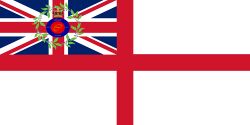Royal Navy (GL)
This article is incomplete because it is pending further input from participants, or it is a work-in-progress by one author. Please comment on this article's talk page to share your input, comments and questions. Note: To contribute to this article, you may need to seek help from the author(s) of this page. |
| Royal Navy | |
|---|---|
 Royal Navy Ensign | |
| Active | 1549 |
| Country | |
| Allegiance | Noctis Lucis Caelum |
| Type | Navy |
| Role | Naval warfare |
| Size | 105,785 personnel 105,000 Royal Marines (55,000 in mainland Lucis; 50,000 in Tristain) 45,785 reserve (Tristain only) 10,795 Royal Fleet Reserve 215 commissioned ships 2,175 aircraft |
| Naval Base | HMNB Devonshire, Lucis, United Kingdom |
| Motto(s) | "Si vis pacem, para bellum" (Latin) "If you wish for peace, prepare for war" |
| March | Heart of Oak |
| Commanders | |
| Lord High Admiral | King Noctis Lucis Caelum of the United Kingdom |
| First Sea Lord | Admiral Karl Kretschmann |
| Fleet Commander | Vice Admiral Shinsuke Takasugi |
| Second Sea Lord | Vice Admiral Henry Temple |
| Insignia | |
| Ensign | |
| Naval Jack | |
| Pennant | |
The Royal Navy イギリス海軍 (RN) is the United Kingdom's naval warfare force. Although warships were used by the English kings from the early medieval period, the first major maritime engagements were fought in the Tristannic Wars against the Atlantic Federation and the Kingdom of Gallia. The modern Royal Navy traces its origins to the early 16th century; the oldest of the UK's armed services, it is known as the Senior Service.
From the middle decades of the 17th century, and through the 18th century, the Royal Navy vied with the Atlantic Navy and later with the Autocratic Imperial Navy for maritime supremacy. From the mid 18th century, it was the world's most powerful navy. The Royal Navy played a key part in establishing the Lucis Empire as the unmatched world power during the 19th and first part of the 20th centuries. Due to this historical prominence, it is common, even among non-Lucians, to refer to it as "the Royal Navy" without qualification.
Following the First Europan War, the Royal Navy was significantly reduced in size, although at the onset of the Second Europan War it was still the world's largest. It vied against the Imperial Quenminese Navy and the Autocratic Imperial Navy for naval supremacy throughout the war. However, the Royal Navy remained more modern than the latter and the former and it consolidated the UK's power in Naval Warfare. It was also instrumental in preventing an invasion of Nihhon-koku by Quenmin during the Battle of Nihhon-koku and as well as in the Battle of the Zanarkian Sea, where the Royal Navy spoiled an imminent invasion of Zanarkand by both Quenmin and Archadia. After the war, it remained as the world's largest and most advanced navy in the world.
The Royal Navy is part of His Majesty's Naval Service, which also includes the Royal Marines. The professional head of the Naval Service is the First Sea Lord who is an admiral and member of the Defence Council of the United Kingdom. The Defence Council delegates management of the Naval Service to the Admiralty Board, chaired by the Secretary of State for Defence. The Royal Navy operates three bases in the United Kingdom where commissioned ships are based; Broadshire, Lislet and Devonshire, the last being the largest operational naval base in Europa.

